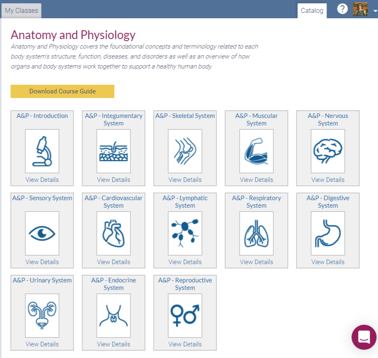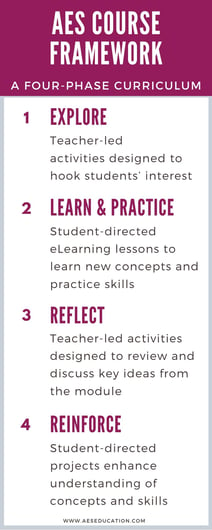Anatomy and Physiology | Health Science | HealthCenter21
How to Teach Anatomy and Physiology with HealthCenter21
For nearly 10 years, Bri has focused on creating content to address the questions and concerns educators have about teaching classes, preparing students for certifications, and making the most of the iCEV curriculum system.
Anatomy and Physiology is one of the most important courses in your CTE health science pathway. Unfortunately, it’s also one of the most difficult classes to keep students engaged and interested in.
Because of this, teachers often ask how they can use our health science curriculum in a year-long Anatomy and Physiology course.
To best implement AES in your Anatomy and Physiology course, we recommend using four pieces of the HealthCenter21 curriculum system:
- The Medical Terminology Module
- The Anatomy & Physiology Curriculum Modules
- The Diseases and Disorders Module
- The Daily Quiz Challenge
In this article, you’ll learn what to expect from each piece and best practices on using them in your A&P course.
Before getting into the details, let’s review how HealthCenter21 is structured so you have success when implementing the curriculum.
Did you previously use the individual Anatomy and Physiology module from AES? Discover tips for transitioning to the new A&P curriculum in your classes.
How Is HealthCenter21 Structured?
HealthCenter21 is a comprehensive curriculum system with more than 1,000 curriculum hours of content organized into learning modules.
These modules each focus on an overarching healthcare topic and are structured according to our four-phase learning plan:
- Explore: Teacher-led activities designed to hook student interest.
- Learn & Practice: Teacher resources and student-directed lessons to help students learn new concepts and skills.
- Reflect: Teacher-led activities designed to review and discuss key ideas from the lessons.
- Reinforce: Student-directed projects that enhance understanding of concepts and skills.
Every module in the AES curriculum includes these phases to help students learn and retain the information presented.
Now that you have an idea of what to expect from HealthCenter21 as a whole, let's dive into how you can teach anatomy and physiology with the curriculum!
1. The Medical Terminology Module
The Medical Terminology module is a great first step for an Anatomy and Physiology course.

In the module, students are introduced to the language of health care workers, including root words, suffixes, prefixes, abbreviations, body planes, directions, and cavities. They also learn to add prefixes and suffixes, form phrases with abbreviations, and interpret medical terms.
Tips for Using the Medical Terminology Module
We recommend following the four-phase course framework to stay organized and provide the best learning experience when implementing the Medical Terminology module.
Start by using the Explore activity to ease your students into the basics of medical terms by completing a word search.
Next, it’s time to incorporate the units from the Learn & Practice phase:
- Unit 1: Word Parts: Roots
- Unit 2: Word Parts: Suffixes and Prefixes
- Unit 3: Abbreviations
- Unit 4: Anatomic References
Each unit includes digital lessons, study resources, review challenges, and assessments to help students learn and use medical terms.
You can utilize these units in one of two ways, depending on your preference:
- Instruct students to complete the units as part of your daily class work
- Require students to complete the units at home before discussing topics in class
After your students have worked through the units, it’s time to incorporate the Reflect and Reinforce activities. These activities work great as supplemental pieces to fill in class time or assign as homework.
As you wrap up this portion of your coursework, use the module test to measure how well your students learned the content.
Overall, the Medical Terminology module will help set students up for success in learning about each body system later in your course!
Pro Tip: The “review games” within the module are great for additional practice and reinforcement. Allow your students to access the Medical Terminology module throughout the entire length of your course to make the most of them!
2. The Anatomy and Physiology Curriculum Modules
The AES Anatomy and Physiology curriculum covers the foundational concepts and terminology related to each body system's structure, function, diseases, and disorders. It also includes an overview of how organs and body systems work together to support a healthy human body.
These topics are taught across 13 learning modules:

- A&P - Intro
- A&P - Integumentary System
- A&P - Skeletal System
- A&P - Muscular System
- A&P - Nervous System
- A&P - Sensory System
- A&P - Cardiovascular System
- A&P - Lymphatic System
- A&P - Respiratory System
- A&P - Digestive System
- A&P - Urinary System
- A&P - Endocrine System
- A&P - Reproductive System
When implementing AES in your Anatomy and Physiology course, these modules will make up the bulk of your material.
Want guidance on implementing the curriculum? Read the pacing guides for a recommended teaching sequence to help you plan your classes: Anatomy and Physiology Curriculum Pacing Guides
Tips for Implementing the Anatomy and Physiology Curriculum
Each A&P curriculum module follows the same structure and includes:
- A body system trivia question activity to engage students and kickstart their thinking
- Self-paced, interactive lessons and assessments for students to learn new information
- Discussion questions for students to reflect on and apply what they learned
- Four reinforcement activities to deepen student understanding of the body systems
In this section, you’ll find tips and recommendations for each piece of the anatomy and physiology curriculum that you can mix and match based on your students’ needs.
Phase 1 - Explore
In the Explore phase of each body system module, you’ll find a Trivia Questions activity. You can use these activities to:
- Create bell ringers that kick off each class period
- Run a trivia game where students team up and compete against each other
- Lead a class discussion to expand on the body system
Phase 2 - Learn & Practice
In the Learn & Practice phase, every A&P body system module includes a unit on Structure and Function and a unit on Diseases and Disorders.
The lessons and assessments in each unit provide your students with a solid foundation of information on each body system.
In the Skeletal, Muscular, and Cardiovascular system modules, you’ll find additional “Extended” units that provide more detail on specific topics related to the system.
Two common ways teachers incorporate the Learn & Practice units are:
- Instruct students to complete the units as part of your daily class work
- Require students to complete the units at home before discussing topics in class
Phase 3 - Reflect
The Reflect phase of each A&P module includes an activity that provides an opportunity for students to reflect upon and apply what they learned to situations.
You can use these reflection questions to expand the conversations in your classroom or assign journal activities to your students.
Phase 4 - Reinforce
In the Reinforce phase of each A&P module, you’ll discover four resources to sprinkle into your lessons where you see fit to deepen your students’ understanding of the body system.
A few ideas for adding a reinforcement activity to your anatomy and physiology classes include:
- Have students learn about careers related to the body system by completing the Careers Research activity.
- Challenge students to take their knowledge deeper by assigning the Diseases and Disorders Research activity for a body system.
- Give students the Crossword Puzzle activity as homework or a study aid so they can review or practice key terminology.
- Have students learn innovations in the field by completing the Advanced Treatment Research project.
Overall, when using the AES Anatomy and Physiology curriculum, it’s easy to adjust how in-depth students explore each body system by deciding which pieces of the four-phase curriculum you assign for each module.
3. The Diseases and Disorders Module

The Diseases and Disorder module provides an overview of various diseases and disorders, explaining the definition, etiology, pathology, presentation, diagnosis, treatment, and prognosis.
When teaching anatomy and physiology, some instructors incorporate the materials from the Diseases and Disorders module to expand on the AES A&P curriculum.
Tips for Incorporating the Diseases and Disorders Module in Your Classes
The Diseases and Disorder module is an expansion of the Anatomy and Physiology topics.
For this reason, we suggest assigning the Diseases and Disorders module after discussing all of the body systems in your course.
By taking this approach, the module’s lessons and activities help students further explore how certain diseases and disorders impact the body systems.
Depending on how your syllabus is laid out, you can assign students to complete these assignments either in-class or as homework.
Pro Tip: The Reinforce project on Diseases and Disorders Research is a great way to wrap up the semester with group work and presentations!
4. The Daily Quiz Challenge
The Daily Quiz Challenge is a unique piece of the HealthCenter21 system that offers a 10-question, non-graded review challenge each day when your students log in.
The questions include topics found within the Medical Terminology and Anatomy and Physiology modules that students often need to practice more.
Tips for Using the Daily Quiz Challenge in Your Classes
The Daily Quiz Challenge is an excellent bell ringer activity to kick off your class every day.
With this daily practice, your students will be able to better recall the information in the future.
We recommend assigning the Daily Quiz Challenge throughout the entire year - before, during, and after you teach the topics found in the daily questions.
In some cases, your students may encounter a question they don’t know the answer to, which is a great learning opportunity.
The Quiz Challenge offers immediate feedback on the question, allowing the student to think critically to narrow down the options and find the correct answer. This process helps to reinforce students’ long-term retention of that information.
Participation in daily practice throughout your entire course will give your students as much practice as possible with the vocabulary, resulting in better long-term retention.
Pro Tip: To encourage your students to participate in the Daily Quiz Challenge, you can review a participation report and highlight students with the highest scores on your class leaderboard!
Teach Anatomy and Physiology (and more) with HealthCenter21
Overall, you can successfully teach a full-year Anatomy and Physiology class with HealthCenter21 as your core curriculum resource.
By incorporating the activities, lessons, assessments, and projects, you’ll set your students up for an engaging learning experience that will help them retain critical information long after they leave your classroom.
However, if you’re like most health science instructors, A&P isn’t the only course you teach.
Thousands of teachers like you use the AES curriculum for classes such as Introduction to Health Science, Medical Assisting, Patient Care Technician, and more.
With 1,000 curriculum hours of content, HealthCenter21 can work in many of your courses to introduce the basics, help students hone skills, and prepare students for certifications.
Using one curriculum resource across all of your courses can save time in planning and better focus on empowering your students for success.
Wondering if HealthCenter21 is right for you and your students? Start your free trial to decide for yourself:



